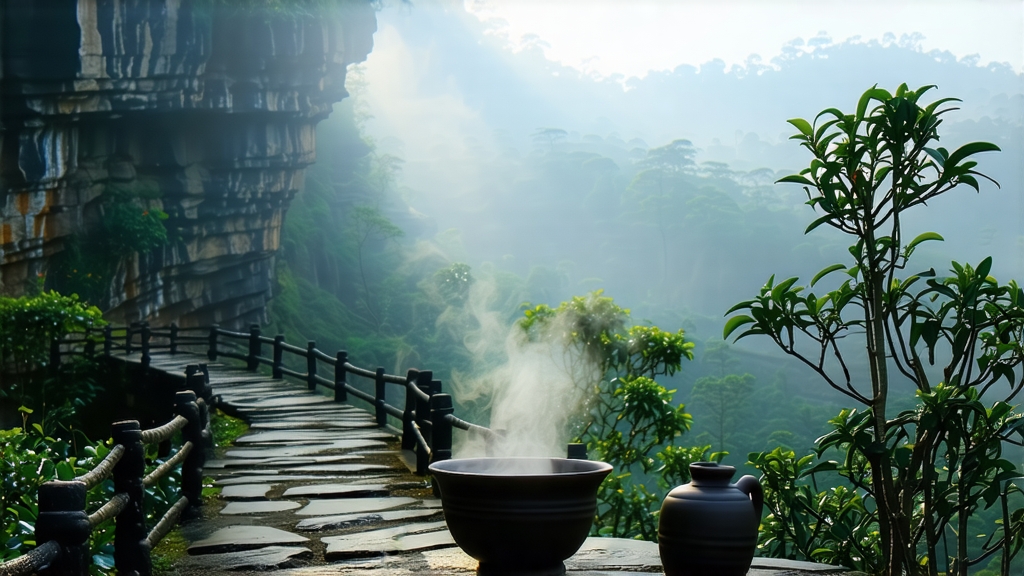
When Chinese tea lovers whisper the words “Da Hong Pao,” they are not merely naming a tea; they are invoking a legend carved into the vertical cliffs of northern Fujian’s Wuyi Mountains. Translated literally as “Big Red Robe,” this most prestigious of oolongs carries a 350-year imperial pedigree, a love story of scholar-saving monks, and a mineral complexity so vivid that local connoisseurs call it “the taste of rock”—yan yun. For international drinkers accustomed to the floral lift of Taiwanese high-mountain oolongs or the creamy softness of Tie Guan Yin, Da Hong Pao offers a dramatic counterpoint: a dark, fire-kissed leaf that brews into a luminous amber liquor tasting of cocoa, orchid, burnt caramel and wet slate.
The historical scaffolding of Da Hong Pao is as layered as its flavor. The earliest written record appears in the 1640s Qing-era gazetteer of Chong’an County, describing six mother bushes clinging to a crevice so narrow that farmers had to tie themselves with rope to harvest them. Myth quickly embroidered fact: a Ming-dynasty scholar, en route to the capital for imperial exams, fell ill at Wuyi’s Tianxin Temple; monks steeped leaves from those bushes, restored him to health, and the candidate went on to place first. Upon returning, he draped his own crimson examination robe over the bushes in gratitude—hence the name. By the Kangxi Emperor’s reign (1661-1722), the tea had become tribute, couriered north in small bamboo-lined chests along the “Tea Road” that began at the Nine-Dragon Gorge and ended behind the Forbidden City’s vermilion walls.
Botanically, Da Hong Pao belongs to the Wuyi qi zhong (“strange cultivar”) family, a diverse gene pool of Camellia sinensis var. sinensis adapted to mineral-rich, weathered tuff cliffs. Today the market recognizes three distinct tiers:
-
Mother-Tree Da Hong Pao: Cuttings from the original six bushes, grown on the same 30 m² ledge inside the “Nine-Dragon Nest” preserve. Harvest is now forbidden; even when allowed (pre-2006), annual yield never exceeded 400 g. Most of what circulates as “mother-tree” is either museum-stored pre-2006 leaf or, more commonly, reverent myth.
-
Pure-Strain Da Hong Pao: Vegetatively propagated descendants (que miao) of the mother trees, cultivated in the 60-hectare “cliff garden” core zone. These plants share identical DNA, root in the same weathered igneous substrate, and are the benchmark for authentic yan yun.
-
Blended Da Hong Pao (or “Commodity Grade”): A skillful marriage of three to five Wuyi cultivars—typically Qi Dan (a direct mother-tree clone), Bei Dou #1, and Rou Gui—designed to mimic the depth and length of the original. When orchestrated by a master, these blends can astonish; when rushed, they flatten into generic roasted flavor.
Crafting Da Hong Pao is a three-week odyssey that begins under the full moon of late April. Pickers pluck the standard “zhong kai mian” (middle-open leaf) comprising one bud and three or four leaves—larger and tougher than green-tea standards, necessary for the bruising to come. The first turning point is yao qing, “rocking the green,” performed on 3-meter-wide bamboo trays. Artisans rhythmically toss the leaves, allowing edges to fracture against tray ribs while cells remain intact. This partial oxidation—halted around 40 %—is what positions oolong between green and black tea.
Next comes the Wuyi signature: two-stage charcoal roasting. Leaves are spread in 3 cm layers inside horse-hair sieves and slid into low-temperature charcoal pits fired by local hardwoods (primarily longan and lychee). The first roast lasts 6–8 h at 80 °C, followed by a week of “sleep” inside hemp-lined baskets to equalize moisture. A second, lighter 60 °C roast fixes the “rock rhyme” and coaxes the famous cocoa note. A third roast is optional, reserved for leaves whose intrinsic fragrance can bear extra fire without collapsing into monotone ash. The entire cycle demands a roaster’s intuition: too little heat and the tea tastes grassy; too much and